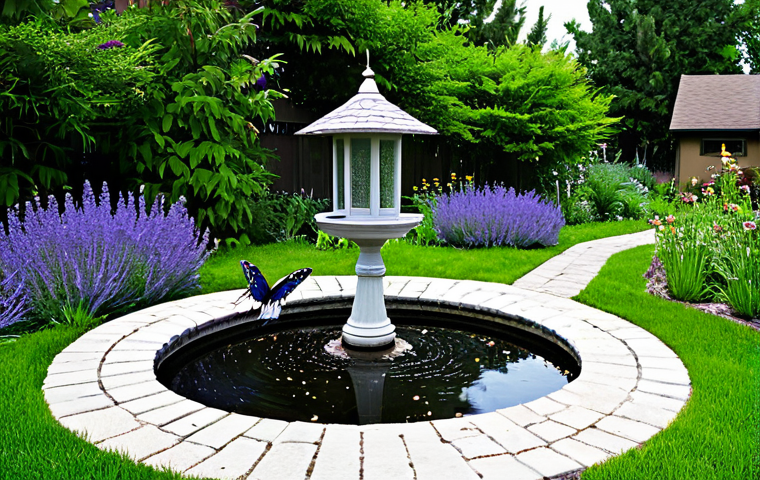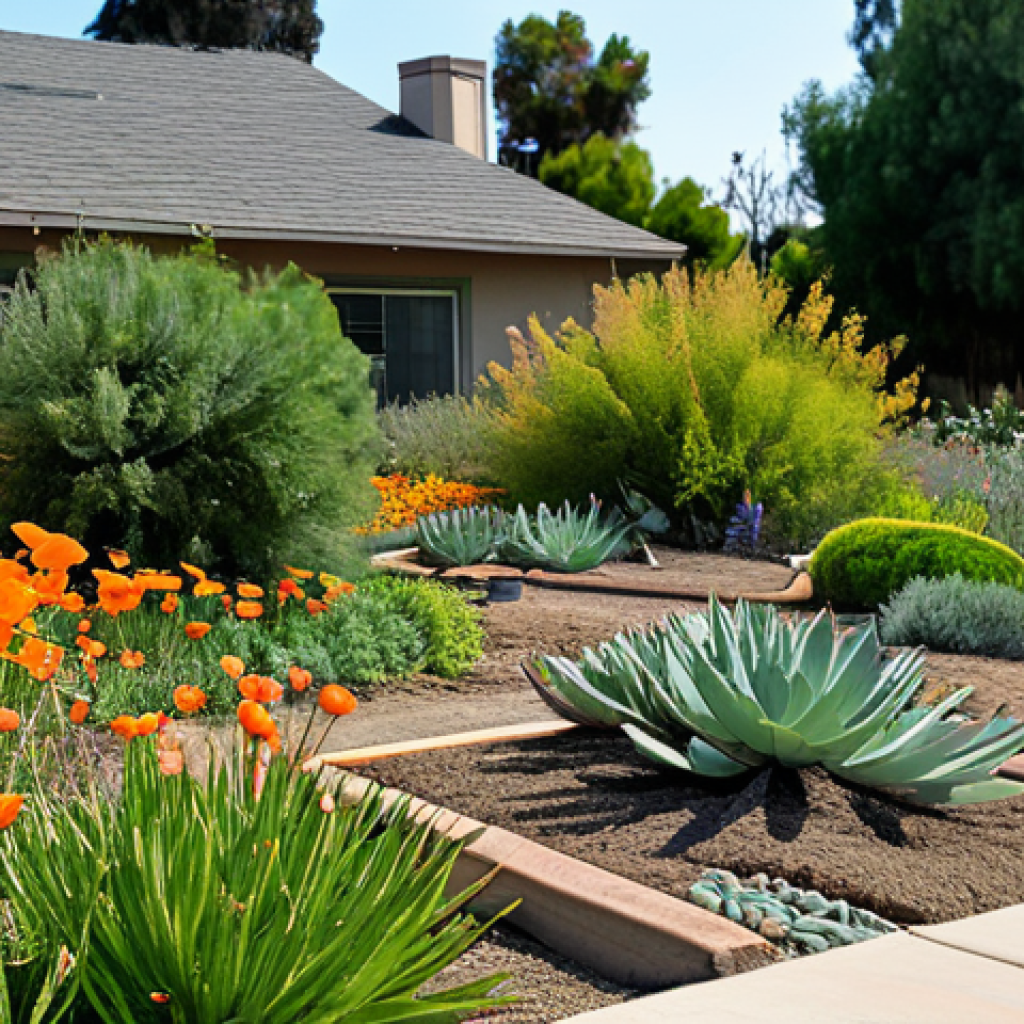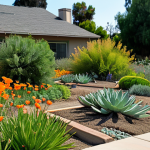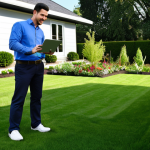Nature’s beauty can be seamlessly woven into landscape design, creating spaces that are not only aesthetically pleasing but also environmentally conscious.
Think about the gentle curve of a pathway mimicking a natural stream, or the strategic placement of native plants to attract local wildlife. I’ve seen firsthand how incorporating natural elements can transform a mundane yard into a vibrant ecosystem.
It’s about understanding the existing environment and enhancing it, rather than imposing a completely artificial design. This approach not only benefits the visual appeal but also contributes to biodiversity and sustainability, aligning with the growing trend of eco-friendly living.
Let’s delve deeper into the various techniques for effectively integrating nature into landscape architecture, ensuring a harmonious blend of design and environment.
Let’s explore this topic further in the following article.
Embracing Native Flora: A Symphony of Local Hues

Understanding Your Region’s Palette
Before even thinking about planting, I always tell my clients: get to know your local flora! This means spending time identifying the native plants that thrive naturally in your area. I’m talking wildflowers, shrubs, trees – the whole shebang. These plants are already perfectly adapted to your climate, soil type, and local pests, which means they’ll require far less maintenance than exotic imports. Plus, they provide crucial food and habitat for native wildlife, turning your garden into a mini-ecosystem.
Sourcing Ethically and Sustainably
Once you know what you want, be mindful about where you get your plants. I’ve seen too many well-intentioned gardeners unknowingly support unsustainable practices. Opt for local nurseries that specialize in native plants and prioritize ethical sourcing. Avoid nurseries that collect plants from the wild, as this can damage natural ecosystems. Look for plants that are grown from seed or propagated from cuttings, ensuring they’re adapted to garden conditions. Don’t be afraid to ask the nursery staff about their sourcing practices – they should be happy to share!
Water-Wise Landscaping: Conserving Precious Resources
Drought-Tolerant Design Strategies
Living in Southern California, water conservation is always top of mind. That’s why I’m a huge advocate for drought-tolerant landscaping. This doesn’t mean your garden has to be a barren desert! It simply means choosing plants that require minimal watering once established. Think succulents, California poppies, and drought-resistant shrubs. Group plants with similar water needs together to optimize irrigation and prevent overwatering. Also, consider using mulch to retain moisture in the soil and reduce evaporation. It’s amazing how much water you can save with a few simple changes.
Smart Irrigation Techniques
Even with drought-tolerant plants, efficient irrigation is key. Ditch the old-fashioned sprinklers that spray water everywhere and opt for drip irrigation or soaker hoses. These methods deliver water directly to the plant roots, minimizing water loss through evaporation and runoff. Install a smart irrigation controller that adjusts watering schedules based on weather conditions and soil moisture levels. I use one at my own home, and it’s saved me a ton of water – and money!
Creating Habitats for Wildlife: A Backyard Sanctuary
Attracting Birds, Bees, and Butterflies
One of the most rewarding aspects of incorporating nature into landscape design is creating habitats for wildlife. It’s so cool to see your garden buzzing with life! Plant flowers that attract pollinators, such as lavender, salvia, and butterfly bush. Install bird feeders and bird baths to provide food and water for feathered friends. Consider adding a small pond or water feature to attract amphibians and other aquatic creatures. The more diverse your landscape, the more wildlife you’ll attract.
Providing Shelter and Nesting Sites
Wildlife needs more than just food and water – they also need shelter and nesting sites. Plant dense shrubs and trees to provide cover for birds and small mammals. Leave some areas of your garden wild and unkempt to create nesting habitat for insects. Consider installing birdhouses or bat houses to provide additional shelter. Avoid using pesticides, which can harm beneficial insects and wildlife. By creating a welcoming environment, you can transform your backyard into a thriving wildlife sanctuary.
Managing Pests Naturally
Speaking of pesticides, let’s talk about pest control. Ditch the harsh chemicals and embrace natural methods. Encourage beneficial insects, such as ladybugs and lacewings, to prey on pests. Use companion planting to deter pests and attract beneficial insects. For example, planting marigolds near tomatoes can help repel nematodes. Handpick pests or use insecticidal soap as a last resort. With a little patience and observation, you can manage pests naturally without harming the environment.
The Art of Stone Placement: Natural Rockscaping
Selecting Local Stone Materials
Integrating stone into your landscape design can add texture, visual interest, and a touch of ruggedness. When selecting stone materials, opt for local options that blend seamlessly with the surrounding environment. Avoid using imported stone, which can be costly and environmentally unsustainable. Visit local quarries or stone yards to find a variety of colors, shapes, and sizes. Consider using recycled concrete or broken pavement as an alternative to natural stone. Not only is it eco-friendly, but it can also add a unique and artistic touch to your landscape.
Creating Natural-Looking Rock Formations
The key to successful rockscaping is creating natural-looking formations. Avoid placing stones in straight lines or symmetrical patterns. Instead, mimic the way rocks appear in nature, with varying sizes and shapes arranged in a seemingly random manner. Bury some of the stones partially in the ground to create a more natural and grounded look. Use smaller rocks and gravel to fill in the gaps and create a cohesive landscape. It takes a bit of practice, but with a little experimentation, you can create stunning rock formations that enhance the beauty of your garden.
Embracing Imperfection: The Beauty of the Wild

Letting Nature Take its Course
One of the biggest lessons I’ve learned in landscape design is to embrace imperfection. Nature is messy and unpredictable, and that’s part of its charm. Don’t be afraid to let your garden evolve and change over time. Allow plants to self-seed and spread naturally. Let leaves decompose on the ground to enrich the soil. Resist the urge to constantly prune and tidy up. By letting nature take its course, you’ll create a more authentic and resilient landscape.
Creating a Low-Maintenance Oasis
The beauty of incorporating nature into landscape design is that it can actually reduce maintenance in the long run. Native plants require less watering, fertilizing, and pest control than exotic imports. Natural stone formations require minimal upkeep. By embracing imperfection and letting nature take its course, you can create a low-maintenance oasis that thrives with minimal intervention. That’s something we can all appreciate!
Table: Comparing Traditional vs. Natural Landscaping
| Feature | Traditional Landscaping | Natural Landscaping |
|---|---|---|
| Plant Selection | Exotic, high-maintenance | Native, drought-tolerant |
| Water Usage | High | Low |
| Pest Control | Chemical pesticides | Natural methods, beneficial insects |
| Maintenance | High | Low |
| Environmental Impact | Negative | Positive |
| Wildlife Habitat | Minimal | Extensive |
| Aesthetic | Formal, manicured | Natural, wild |
Sustainable Materials: Building with the Earth in Mind
Reclaimed Wood and Recycled Elements
I’m a big fan of incorporating sustainable materials into my landscape projects. Using reclaimed wood for decks, fences, or raised garden beds not only adds character but also reduces the demand for new lumber. Similarly, recycled materials like crushed glass or shredded tires can be used for pathways or mulch, diverting them from landfills. When I renovated my own backyard, I sourced reclaimed bricks from a demolished building for the patio. It added a touch of history and reduced my carbon footprint. Look around your community for suppliers offering these eco-friendly alternatives!
Permeable Pavers and Green Roofs
Traditional paving materials can contribute to stormwater runoff and heat island effect. Opting for permeable pavers allows rainwater to seep into the ground, replenishing groundwater and reducing flooding. Green roofs, covered in vegetation, provide insulation, reduce stormwater runoff, and create habitat for wildlife. While they might require a larger upfront investment, the long-term environmental benefits are significant.
Lighting Strategies: Illuminating Nature Responsibly
Solar-Powered Lighting Solutions
Outdoor lighting can enhance the beauty of your landscape, but it’s important to choose energy-efficient and environmentally friendly options. Solar-powered lights are a great choice for pathways, accent lighting, and garden features. They’re easy to install, require no wiring, and operate on renewable energy. I’ve found that they’re also incredibly reliable, lasting for years with minimal maintenance.
Minimizing Light Pollution
It’s crucial to minimize light pollution when designing outdoor lighting. Use shielded fixtures that direct light downwards, preventing it from spilling into the night sky. Avoid over-lighting your landscape – less is often more. Choose warm-toned LED lights with low lumen output to create a soft and inviting ambiance. Not only will this reduce energy consumption, but it will also protect nocturnal wildlife and preserve the beauty of the night sky.
In Conclusion
Incorporating nature into landscape design isn’t just a trend; it’s a shift towards a more sustainable and harmonious way of living. By embracing native plants, conserving water, creating wildlife habitats, and using sustainable materials, you can transform your outdoor space into a thriving ecosystem. Remember, the goal is to work *with* nature, not against it. So get out there, get your hands dirty, and let your garden be a reflection of the natural world around you. You might be surprised by what you discover!
Handy Tips to Keep in Your Back Pocket
1. Soil Testing is Key: Before you even think about planting, get your soil tested! A simple soil test will tell you its pH level and nutrient content, allowing you to amend it accordingly for optimal plant growth. I always recommend it to my clients; it saves so much heartache down the road.
2. Composting is Your Friend: Start a compost bin! Composting is a fantastic way to recycle kitchen scraps and yard waste into nutrient-rich soil amendment. It’s also incredibly satisfying to turn waste into something valuable for your garden. I’ve been composting for years, and my plants have never been happier.
3. Rain Barrels for the Win: Collect rainwater! Rainwater is naturally soft and free of chemicals, making it ideal for watering plants. Install rain barrels to collect rainwater from your roof and use it to supplement your irrigation. It’s a simple way to conserve water and reduce your reliance on municipal water sources. My neighbor swears by his rain barrel system; he says his roses have never looked better!
4. Mulch, Mulch, Mulch: Use mulch! Mulch is a gardener’s best friend. It helps retain moisture in the soil, suppress weeds, regulate soil temperature, and add organic matter as it decomposes. Choose organic mulches like wood chips, shredded bark, or straw. I like to use pine straw in my garden; it’s readily available and adds a lovely texture to the landscape.
5. Observe and Adapt: Pay attention to your garden! Gardening is an ongoing learning process. Observe your plants closely and adapt your approach as needed. Notice which plants thrive in certain areas and which ones struggle. Learn from your mistakes and celebrate your successes. Remember, there’s no such thing as a perfect garden – just a constantly evolving one.
Key Takeaways
Focus on native plants adapted to your local climate.
Implement water-wise strategies like drip irrigation and mulch.
Create habitats for birds, bees, and butterflies.
Use sustainable materials like reclaimed wood and permeable pavers.
Minimize light pollution with shielded fixtures and warm-toned LEDs.
Embrace imperfection and let nature take its course for a low-maintenance oasis.
Frequently Asked Questions (FAQ) 📖
Q: I’m just starting out with landscape design. What’s the easiest way to bring a touch of nature into my backyard without a complete overhaul?
A: Honestly, the simplest thing you can do is focus on native plants. I remember when I first moved into my place, the yard was just sad, boring grass. I started swapping out patches with wildflowers and shrubs native to my region.
Not only did it add some much-needed color and texture, but suddenly butterflies and birds started showing up! It was like instantly creating a mini-ecosystem.
Plus, native plants are usually super low-maintenance since they’re already adapted to the local climate. No need to fuss with crazy watering schedules or special fertilizers.
Trust me, it’s a game-changer.
Q: I love the idea of a natural landscape, but I’m worried about attracting unwanted wildlife, like mosquitoes or even larger critters. How do you balance the beauty of nature with keeping things safe and manageable?
A: That’s a totally valid concern! My neighbor actually had a similar worry. He ended up creating a small water feature—a birdbath, really—but positioned it away from the house and kept the water circulating to prevent mosquito breeding.
Also, he made sure to keep his grass trimmed around the edges and any piles of leaves cleared. Basically, you want to encourage the good wildlife (birds, butterflies) and discourage the pests.
Think about adding plants that naturally repel insects, like citronella or lavender. And if you live in an area with larger animals, ensure you have proper fencing or deterrents to keep them from getting into your garden.
It’s all about creating a healthy balance and being mindful of the specific wildlife in your area.
Q: Eco-friendly landscape design sounds expensive.
A: re there budget-friendly ways to incorporate natural elements without breaking the bank? A3: Absolutely! You don’t need a fortune to create a natural, beautiful space.
I’ve always been a big fan of DIY projects and repurposing materials. For example, instead of buying new stone for a pathway, you could use reclaimed bricks or even create stepping stones from concrete and embed decorative elements you find in nature, like leaves or pebbles.
Also, consider propagating your own plants from cuttings or seeds – it’s way cheaper than buying them fully grown. And don’t underestimate the power of composting!
Using your own compost to enrich your soil not only reduces waste but also saves you money on fertilizer. Little by little, these sustainable choices can transform your yard without emptying your wallet.
📚 References
Wikipedia Encyclopedia
구글 검색 결과
구글 검색 결과
구글 검색 결과
구글 검색 결과
구글 검색 결과





